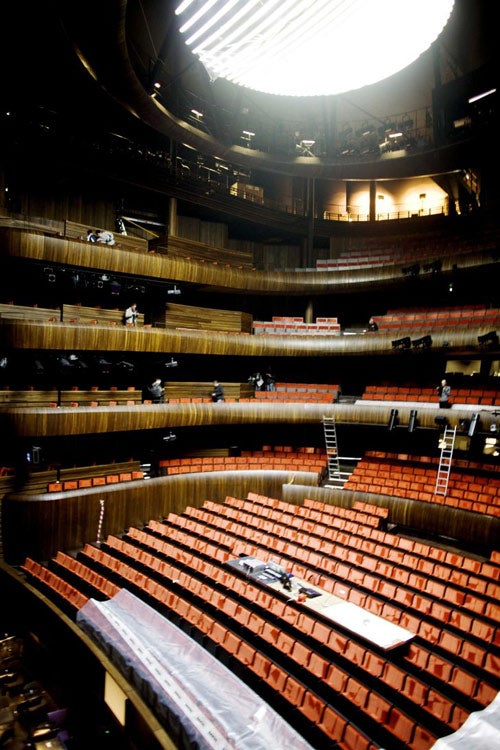Tra la! Oslo's opera goes upscale at last
Norway's capital has had to wait more than 100 years for its first purpose-built opera house. Not only has the new construction revitalised the city's old docklands area, but spectators even have their own private beach. Adrian Mourby reports

'Move over, Sydney!" cries Bjorn Simensen and we raise a glass. Bjorn is director of Norske Opera and he has reason to be in a bullish mood. He's just learned that as planes make their approach into Oslo, his shiny new waterfront opera house is clearly visible from the air.
We're sitting in Dovre Hallen, a famous downbeat haunt for Oslo's drinking fraternity, Bjorn, me and a bottle of red wine, and we're toasting his other big reason to rejoice. Yesterday, Norway's first purpose-built opera house opened to the public, more than 100 years since it was first proposed.
Back in the 1890s when a new national theatre was proposed for the capital, Edvard Grieg suggested that it should double as an opera house. Ibsen put a stop to that. "Opera is the cuckoo in the nest," he declared, and opera has been the poor relation in Oslo ever since. In 1959 it was found a temporary home by the great Norwegian soprano Kirsten Flagstad. That home was a converted 1940s cinema in the middle of a 1930s shopping arcade. As a musical venue it was every bit as dire as it sounds.
But now a new state-of-the-art opera house sits half a mile away on Oslofjord. It looks like a sleek, white iceberg covered in Carrera marble melting slowly into the harbour. Bjorn had lobbied for it for 10 years, by which time he saw just about every major city in Scandinavia get a new house, but not Oslo. Finally, a deal was done with the politicians. If the new house could be built down in the unfashionable east end of the city's waterfront, money would be forthcoming as part of an urban renewal project.
It's a story told the whole world over – Cardiff, Sydney, Singapore, Gothenburg – if no one wants to live in your derelict dockland, build a world-class opera house nearby. The amazing thing is, it works. Before Oslo's new Operaen even opened, big accountancy firms and hotel chains began moving into an area that until recently was visited only by pollution experts. More than 90,000 tons of contaminated sediment had to be removed from this end of Oslofjord before the land could be declared safe for building.
Last year a bunch of local politicians actually swam off the end of the opera house to prove how clean the water is now. And that's one of the things that makes Bjorn's baby unique: the roof slopes down into the harbour to provide a beach for swimmers. Not even Sydney Opera House thought of that one.
At the moment there's still a lot of work to be done before the city achieves its aim of knitting together the two halves of its waterfront. Oslo has always been divided east and west, either side of Akershus Castle. The west end has the theatres, banks and bistros, the museums, the royal palace and its own castellated railway station (now converted into the Nobel Peace Prize Centre). The east end has its own railway station, too (still a railway station), plus shopping centres, road works and a grim old cinema that thinks it's an opera house. It also has the E18, a four-lane highway that thunders with 120,000 vehicles a day, rattling the new harbourside Operaen.
"By 2011 that will all be in a tunnel under the fjord," says Bjorn. "Then the two halves of the city can come together." It's an ambitious project, but you can see it happening.
When I visited the new opera house last year, large sections of concrete tunnel were floating in the water, ready to be submerged. The building itself looked as good as it should at a cost of €455m. It's covered in 38,000 pieces of hand-cut Carrera marble; the auditorium is lined with Baltic oak which has been soaked in Armagnac to give it just the right hue (wood stain wouldn't do, of course!), and the seatbacks contain individual surtitling screens in eight different languages. Boat builders from the north-west coast of Norway have carved the balconies, and a 1,000-piece circular chandelier has been built by a firm in Hadeland, north of Oslo. "Reassuringly expensive," sums it up very well.
"Now all we have to do is get rid of the ferries," says Bjorn. "They're too big. They detract from the opera house. We'll send them round the corner!"
Currently the opera house and its affluent new neighbours, PriceWaterhouse and Ernst & Young, do seem somewhat isolated down this eastern end of the harbour, but the steady march of wine bars along the waterfront is under way. Aker Brygge harbour in the west is already overrun with trendy eateries. Eastward expansion can only follow. The huge Havnelager warehouse, Operaen's nearest neighbour, has already been converted into an expensive office block. Give it a decade and you'll be picking up leaflets for the Oslo Harbour Walk at the airport: 4km of recreation space, shops and refurbished historic landmarks.
Let no one underestimate the power of opera. Regeneration is in the bag. It's all over, bar the singing. That started yesterday.
COMPACT FACTS
How to get there
Adrian Mourby flew with SAS (0871 521 2772; flysas.com), which offers return flights to Oslo from £108. He stayed at the Thon Opera (00 47 24 10 30 00; thonhotels.no/opera), which offers b&b from Nkr1,095 (£110).
Further information
Oslo Opera House (oslooperahouse.com).
Subscribe to Independent Premium to bookmark this article
Want to bookmark your favourite articles and stories to read or reference later? Start your Independent Premium subscription today.

Join our commenting forum
Join thought-provoking conversations, follow other Independent readers and see their replies